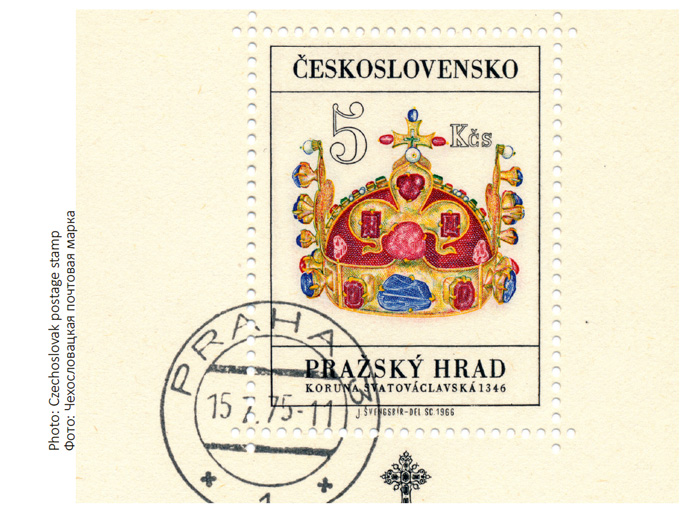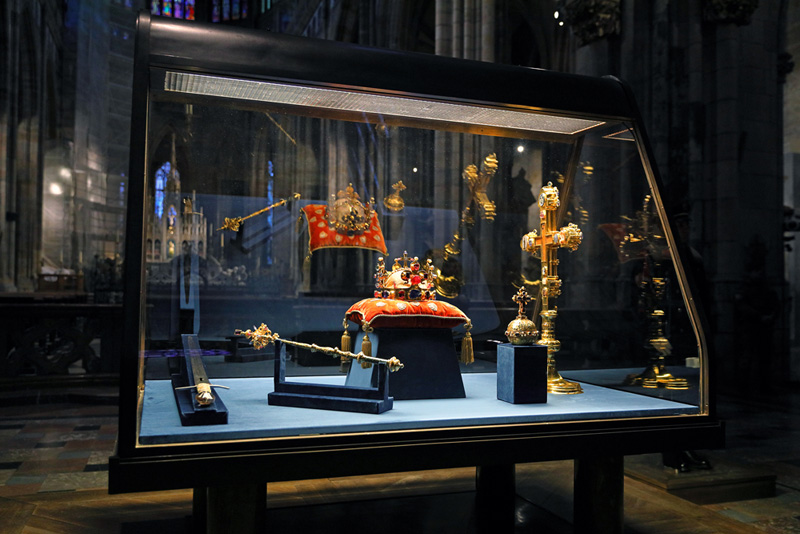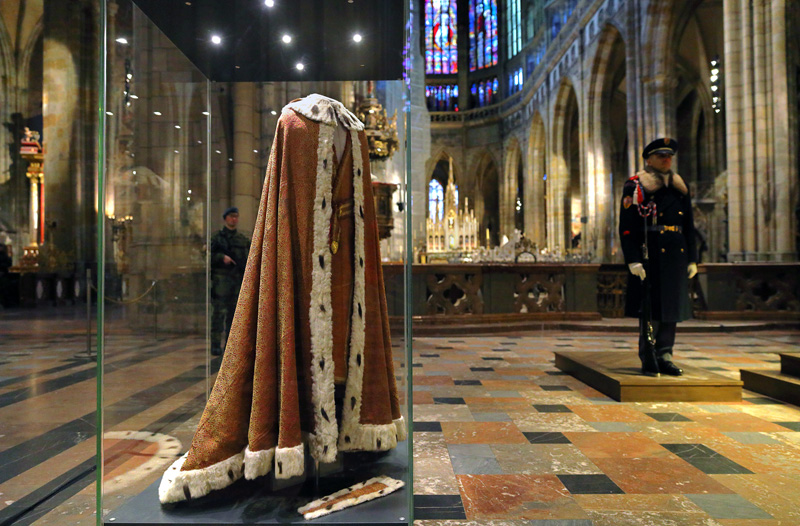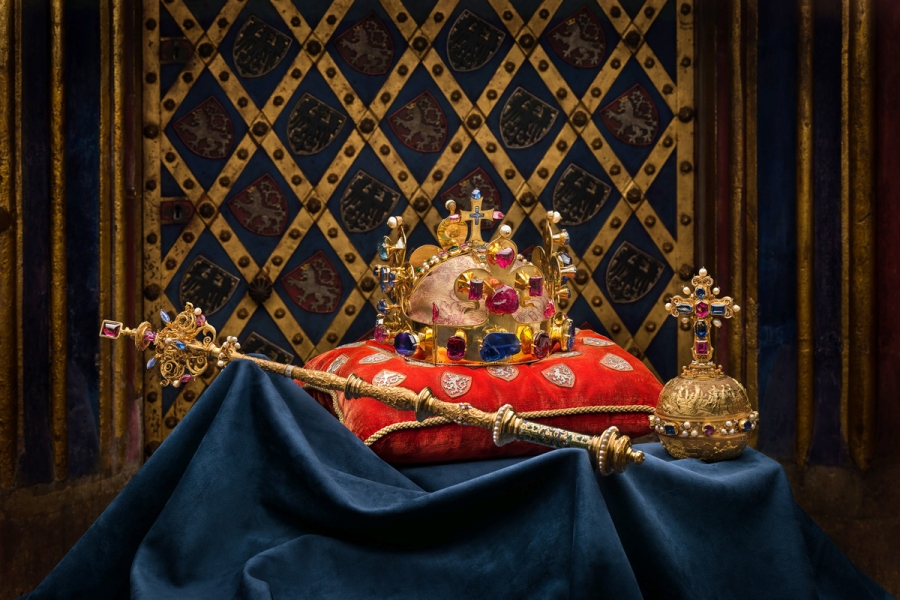Photo archive: Kancelář Prezidenta Republiky, photo: Jan William Drnek.
SYMBOLS OF CZECH STATEHOOD
The Bohemian Crown Jewels are one of the few European symbols of state power to have survived since the Middle Ages.
The Bohemian Crown Jewels include The St. Wenceslas Crown, the Royal Sceptre, the Royal Apple and the Coronation Cloak, Cross and Sword of St. Wenceslas.
The first public exhibition of the Bohemian Crown Jewels took place in 1929. The national jewels were displayed in a showcase designed especially for the exhibition by the architect Josef Gočár in 1929. The Bohemian Crown Jewels were presented to the public in the same showcase in Prague’s St. Vitus Cathedral from 17 to 24 January 2023. During these eight days, the exhibition was visited by almost 34,000 people, and it can undoubtedly be called the most important social and cultural event in the life of the country.
Text: Boris Kogut, based on numerous publications.
The St. Wenceslas Crown is the most important national treasure among the Bohemian Crown Jewels. The St. Wenceslas Crown is made of 21–22 carat pure gold, 1 mm thick and weighs 2358 grams.
It is decorated with 96 precious stones — sapphires, emeralds, spinels, rubies, rubellites, aquamarines and 20 magnificent pearls.
Surviving sources do not reveal the exact date of the Crown’s creation. There is only speculation that it was made as early as 1341, when preparations were being made for the coronation of Margrave Charles as King of Bohemia. However, it is known that the heir to the Czech throne, Charles IV, then Margrave of Moravia, gave the order to create a new precious Crown, the St. Wenceslas Crown.

It is first mentioned in a protective bull of Pope Clement VI dated 6 May 1346. The Crown was modelled on an older crown of the Přemyslid dynasty.
On the original leather casket of the Crown, under the symbols of the Roman Empire and the Bohemian Kingdom, there is an inscription stating that the Crown was made in 1374 by Charles, King of Rome and the Bohemian Kingdom. The new St. Wenceslas Crown was first crowned by Archbishop Arnošt of Pardubice to Charles and his wife Blanka on 2 September 1347 in Prague Castle, in the old chapel of St. Vitus Cathedral.
The oldest inventory record of the cathedral (1354) mentions a new crown of pure gold and precious stones as a gift from Charles IV to St. Wenceslas.
The coronation ceremony began at Vyšehrad. There, in the ancient fortress that was the residence of Czech princes in the 11th and 12th centuries, the heir to the throne had to bow down before the bast shoes and purse of Přemysl Pahar, the founder of the Přemyslid princely and royal dynasty that ruled Bohemia from the earliest times until 1306. The monarch, surrounded by his entourage, then made a solemn coronation procession through the streets of Prague to St Vitus Cathedral.
A religious ceremony (anointing) took place in the cathedral, where the monarch was officially crowned and invested with the Bohemian Crown Jewels.
Charles IV decreed that the heirs to the royal throne should be crowned with the St. Wenceslas Crown, but they had the right to use it only on the day of their coronation, on which it had to be deposited overnight in the Prague sacristy. The rest of the time it rested on the skull of St. Wenceslas, to whose legacy monarchs had to swear allegiance.
The Crown was originally kept in St. Vitus Cathedral.
At the beginning of the 15th century, King Wenceslas IV (1378–1419) decided to move the Bohemian Crown Jewels to the impregnable castle of Karlštejn, under the influence of growing popular unrest that was spreading throughout the Bohemian Kingdom.

Photo: Boris Kogut.
Over the years, the Crown has travelled abroad, returning to Karlštejn in times of danger. The Crown has changed its location many times, including Prague Castle and the Old Town Hall. During the Thirty Years’ War, the Bohemian Crown Jewels were hidden in a church in České Budějovice, where they were moved in the autumn of 1631. The Crown was also kept in Vienna for a long time. It was first taken there for safekeeping in 1637.
However, it is difficult to determine where the Bohemian Crown Jewels were kept after 1639. However, it is worth noting that wherever the Bohemian Crown Jewels were kept, whether at Karlštejn or in Vienna, they were always transported to Prague for the coronation of the new Czech Monarch, accompanied by armed guards.
The Bohemian Crown Jewels remained in Vienna until 9 August 1791 — during the reign of Leopold II, at the request of the Bohemian estates, they were again transported to Prague and placed in the Svatovaclava Chapel.
This period also saw the establishment of new custodians of the Bohemian Crown Jewels and custodians of the keys to the Prague part of the Crown Archives. Seven keepers of the keys to the treasury of the Czech Kings were appointed at that time.
The Bohemian Crown Jewels were again hastily evacuated to Vienna in 1866 during the Austro-Prussian wars. A year later, in 1867, when the return of the treasures to Prague became a Czech
national holiday, the Bohemian Crown Jewels were placed in the Crown Chamber above the Chapel of St. Wenceslas in the St. Vitus Cathedral, where they remain today.
To open the door of the Crown Chamber and the armoured jewellery box, seven holders of the keys to these vaults must meet simultaneously: the President of the Republic, the Prime Minister, the Prague Archbishop, the Chairman of the House of Deputies, the Chairman of the Senate, the Dean of the Metropolitan Chapter of St. Vitus Cathedral and the Lord Mayor of Prague.
The Czech Republic owns the Royal Apple and the Royal Sceptre, which were probably made for Emperor Ferdinand I in 1533. They were made of 18‑carat gold by the Augsburg jeweller Hans Haller.

Photo: Boris Kogut.
The Coronation Cloak is woven of precious silk and dates from around 1617. However, another source states that it was sewn in 1653 at the behest of King Ferdinand IV. The Cloak is 312 cm wide and 236 cm long. It may have been made for Ferdinand II, who was crowned in 1617.
The 2016 publication by the Prague Castle Administration, «The Royal Sceptre and the St. Wenceslas Crown: Karel IV and the Czech Royal Coronation» states: «Since all three Royal Jewels (the St. Wenceslas Crown, the Royal Apple and the Royal Sceptre) were kept together in the Vienna Treasury during the 17th century, the Royal Apple and the Royal Sceptre of Emperor Ferdinand I were joined with the St. Wenceslas Crown in Vienna.
Zdeněk Koudelka, author of the new book The Czech Crown Jewels in Austria, writes: «This was not a deliberate action on the part of the King or representatives of the Czech estates. The Czech estates, who took the initiative to return the jewels to Prague in 1791, did not know that the Bohemian Gothic (14th century) Royal Apple and the Royal Sceptre were also kept in Vienna.
The Bohemian Crown Jewels returned at that time, consisting of the St. Wenceslas Crown and the Renaissance (Emperor Ferdinand I) Royal Sceptre and Royal Apple used at coronations, were considered to be a complete set of the correct and only Czech Crown Jewels».
The Hofburg Museum in Vienna owns «the Royal Sceptre and the Royal Apple of the Bohemian Kingdom, made of gilded silver in Prague in the 14th century» — reads the caption on the original of The Czech Crown Jewels on display at the museum.
In 1836, Ferdinand V became the last Czech King to be crowned with the St. Wenceslas Crown, and five days later his wife, Maria Anna of Savoy, became the last Czech Queen to be crowned with the St. Wenceslas Crown.
A total of 41 noble persons of royal blood were crowned with the most precious St. Wenceslas Crown.









